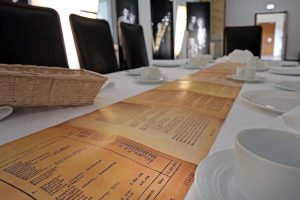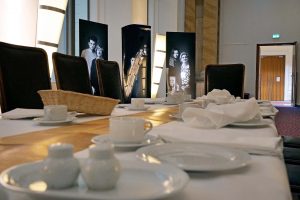About
The Historical Event
WE! ARE! HERE! counteracts the depersonalisation of the National Socialist regime
Since the protocols became known to the public, intensive research has been conducted on its 15 participants. The focus has always been on their biographies, their upbringing and their psychological imprinting.
The other ‘participants’ in the conference have always simply been ‘the eleven million Jews to be murdered’ or ‘the six million murdered’.
For many years, in scholarly books, as well as in memorial culture initiatives, historian Julien Reitzenstein has been bringing those who were previously considered to be ‘the victims’ out of anonymity and giving them back their names, their identities and their faces.
With this motivation, he has developed an artistic commemorative concept which, following the previous intensive preoccupation with the perpetrators of the Wannsee Conference, makes visible those who, according to the conference protocol, were supposed to be murdered – and escaped their murder.
The artistic-academic commemorative concept of WE! ARE! HERE!
One of the focuses of WE! ARE! HERE! is making individual people visible – those who, according to the will of the perpetrators, should not have been alive for decades. The exhibition also focuses on a change of perspective: when talking about the Shoah and its consequences, the focus is usually directed on the past. But the Shoah is not just a chapter in history books – something that can be closed and forgotten. Its consequences impact the present and the future, not only for the families that were persecuted by the Nazi regime, but also for society. WE! ARE! HERE! not only portrays survivors of the Shoah and lets them recount their past, but it also portrays their grandchildren and great-grandchildren; it also looks to the future, for the perpetrators did not succeed in murdering all the Jews of Europe. Jewish life is part of our present. The grandchildren and great-grandchildren show that Jewish life will also be with us in the future.
In this way, WE! ARE! HERE! also sends a message against the antisemitism of our times. The WE! ARE! HERE! installation confronts the viewer with various arcs of tension:
- The 15 chairs of the perpetrators are empty. The perpetrators are gone and died long ago. On the table, lies the conference protocol that envisaged the murder of those whose portraits surround the table. They shout: ‘WE! ARE! HERE! – and so are our descendants!’
- The people in the portraits outnumber the 15 seats at the conference table.
- The text stelae next to the portraits have two columns. In the left column, you can read excerpts from the survival stories of the portrayed survivors that will be published in the WE! ARE! HERE! book. They describe their thoughts in their own words – detailed, free, personalised and self-determined. In the right column, concise information on each perpetrator is presented in sober encyclopaedic language. The survivors dominate the perpetrators not only in the length of their text but also in the individuality of their language.
- Above the encyclopaedic notes about the perpetrators are their photos. However, while the survivors and their descendants stand life-sized in the exhibition, the perpetrators are only depicted in very small photos.
- The life-sized portraits of the survivors are clear and present; the small photos of the perpetrators are artificially faded. The perpetrators are only recognisable as shadows. The survivors and their descendants push the perpetrators out of history through these arcs of tension. The survivors stand in the centre and shout: ‘WE! ARE! HERE!’
The Photographic Concept of WE! ARE! HERE!
With this photographic concept, we want to show hope, to look to the future and to point to life. At the same time, we want to create images that combat forgetfulness, images that are not easily overlooked, images that stick, images that cannot be shut away – a contemporary document.
This series of portraits unites the past, present and future in individual photographs. It shows (great) grandfathers and grandmothers next to (great) grandchildren in a 200×60 cm analogue black and white portrait. There is no background, no physical reference points – just empty space and two people visible from head to toe, standing together in a tall, narrow format.
These pictures are not only intended to focus on the witnesses, their survival and their unimaginable suffering, but also to look to the future!
It is precisely through the de-contextualisation of the people portrayed in the photographs that the viewer is shown a new perspective. The viewer only sees people. Concrete people. With names, with lives, with stories. This makes the human crime of the Shoah personal – it creates what an abstract representation cannot. It makes the enormity of the crimes palpable because when the people in the photographs face the viewer in their life-sized form, the viewer is not prepared, and it grips them. If the perpetrators had completed their plan, the viewer would never have been able to stand in front of the photo, and the child in the portrait would not be with us today.
The Camera leaves out everything that could obscure a pure view of the subjects and concentrates solely on the image of the person(s) – their personalities, as it were. An artistic, aesthetic and tender view of the person in the photograph opens the viewer’s eyes. An emotional impression intended to preserve history is created.
The Future of WE! ARE! HERE!
After premiering at the Berlin Parliament building on 20 January 2022, the 80th anniversary of the Wannsee Conference, the installation is set to travel the world. In the process, more survivors will be portrayed, and the installation will, therefore, be continuously expanded. At the end of the journey, WE! ARE! HERE! will return to Berlin and will be on permanent display from 8 May 2025, the 80th anniversary of the end of the war. As a contemporary testimony that shows the last survivors and a change of perspective when looking at the Shoah, the focus of the exhibition is not on the perpetrators but on those they persecuted.

